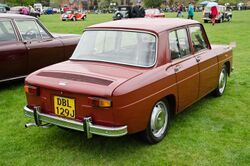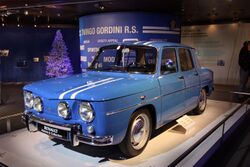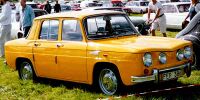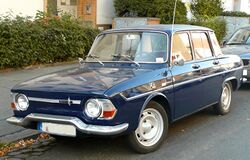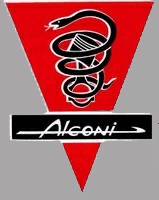Engineering:Renault 8 and 10
| Renault 8 / Renault 10 | |
|---|---|
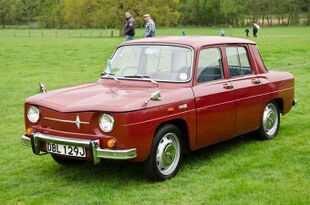 1971 Renault 8 | |
| Overview | |
| Manufacturer | Renault |
| Also called | Renault 10 Renault 1100[1] Dacia 1100 Bulgarrenault 8/10 Khouvieng Type 10 |
| Production | 1962–1973 (Renault 8) 1965–1971 (Renault 10) 1965–1976 (Spain, Renault 8) 1966–1970 (Bulgaria, Bulgarrenault) 1968–1971 (Romania, Dacia) |
| Assembly |
|
| Body and chassis | |
| Class | Small family car (C-segment) |
| Body style | 4-door saloon |
| Layout | Rear-engine, rear-wheel-drive |
| Powertrain | |
| Engine | 956 cc I4 1100 cc I4 1255 cc I4 1289 cc I4 |
| Transmission | 3-speed manual 4-speed manual 5-speed manual |
| Dimensions | |
| Wheelbase | 2,270 mm (89.4 in)[3] |
| Length | 4,000 mm (157.5 in) (Renault 8) 4,200 mm (165.4 in) (Renault 10)[4] |
| Width | 1,490 mm (58.7 in) |
| Height | 1,375 mm (54.1 in)[4] |
| Chronology | |
| Predecessor | Renault Dauphine |
| Successor | Renault 12 |
The Renault 8 (Renault R8 until 1964) and Renault 10 are two rear-engined, rear-wheel drive small family cars produced by the French manufacturer Renault in the 1960s and early 1970s.
The 8 was launched in 1962, and the 10, a more upmarket version of the 8, was launched in 1965. The Renault 8 ceased production and sales in France in 1973. By then the Renault 10 had already been replaced, two years earlier, by the front wheel drive Renault 12.
They were produced in Bulgaria until 1970 (see Bulgarrenault), and an adapted version of the Renault 8 continued to be produced in Spain until 1976. In Romania, a version of the 8 was produced under license between 1968 and 1972 as the Dacia 1100. In total 37,546 Dacia 1100s were built.[5]
Renault 8
Launch
The R8 (model R1130) was released in June 1962[3] and was based on the Renault Dauphine, with which it shared its basic architecture and its 2,270 mm (89.4 in) wheelbase. The style, closely following that of the first prototype produced, at unusually short notice, by Philippe Charbonneaux, was fashionably boxy; however,[3] while the Renault 8 was actually 30 mm (1.2 in) narrower than the Dauphine, the manufacturer was able to install thick cushioned front seats that were actually each 60 mm (2.4 in) wider, at 560 mm (22.0 in), than those fitted in the Dauphine.[3]
The 8 was powered by an all new 956 cc Cléon-Fonte engine developing 44 PS (32 kW; 43 hp). The R8's engine followed the pioneering example of the recently introduced Renault 4 by incorporating a sealed for life cooling system.[3] A distinctive innovation on the French produced cars was the fitting of four-wheel disc brakes, a first for a saloon car of this size.[3] However, when in 1965 Renault's Spanish affiliate[6] introduced their own version of the Renault 8 for the (then tariff-shielded) Spanish market, it came with drum brakes.
The 8 was sold in the United States with an unusual marketing approach that acknowledged that the previous Dauphine had many shortcomings for American owners, and that the 8 was an improvement.[7] While an all new engine was built that was more powerful, and many changes were made, most of the criticism summarized the 8's shortcomings when driving on the recently constructed United States Interstate Highway System as the car was built for French driving conditions which were much more localized. When driving the 8 in city environments, it is nimble and easy to get around crowded conditions. France did not begin to build the Autoroutes of France until French Law 55-435 was passed April 18, 1955, to create a similar highway system previously built in Germany, called the Autobahn during the 1930s.
Automatic transmission
For 1963 (initially only in France), Renault offered an automatic transmission of unique design, developed and produced by Jaeger.[8] It was first shown at the September 1962 Paris Motor Show.[9] Although it was described as a form of automatic transmission at the time, in retrospect it was more realistically a form of automatic clutch, inspired by the German Saxomat device which appeared as an option on several mainstream German cars in the 1950s and 60s.
The clutch in the system was replaced by a powder ferromagnetic coupler, developed from a Smiths design.[9] The transmission itself was a three-speed mechanical unit similar to that of the Dauphine, but from the beginning with synchromesh on all gears in this version.
The system used a dash-mounted push button control panel where the driver could select forward or reverse and a governor that sensed vehicle speed and throttle position.
A "relay case" containing electromagnetic switches received signals from the governor and push buttons and then controlled a coupler, a decelerator to close the throttle during gear changes, and a solenoid to select operation of the reverse-first or second-third shift rail, using a reversible electric motor to engage the gears. The system was thus entirely electromechanical, without hydraulics, pneumatics or electronics. The relay case was located in the front trunk. On cold days, with no source of heat in the trunk area, the relays would freeze and required the "Open, Push, Whack, and Jump". Essentially, the driver had to open the trunk, push the Drive button on the dashboard, whack the relay box, and jump back into the moving vehicle. On extremely cold days, the relay box was unreliable and intermittent, seemingly having a mind of its own.
Benefits included comparable fuel economy to the manual transmission version, and easy adaptability to the car. Drawbacks included performance loss (with only three available gears) and a somewhat jerky operation during gear changes.
The transmission was also used in the Dauphine and the Caravelle.
Engine upgrades
A more powerful model, the 8 Major (model R1132), was released in 1964, featuring an 1108 cc engine developing 50 PS (37 kW; 49 hp). A still more powerful version, the 8 model R1134 Gordini, was also released that year, with a tuned engine of the same capacity but developing 90 PS (66 kW; 89 hp). The extra power was obtained by a cross-flow head and twin dual-choke 40mm side-draft Solex carburetors. A four-speed close ratio manual transmission, dual rear shock absorbers and uprated springs were fitted. The R1134 Gordini was originally available only in blue, with two stick-on white stripes. It was also distinguishable from the 8 Major by the bigger 200mm headlamp units. In 1965, the Renault 10 Major, a more luxurious version of the 8 with different front and rear styling, was released, replacing the 8 Major.
Facelift

In 1967, the R8 Gordini (model R1135) received a facelift including two additional headlights (in effect Cibie Oscar driving lights), and its engine upgraded to a 1255cc unit rated at 100 PS (74 kW; 99 hp). The R1134 Gordini cross-flow head design was retained, and twin dual-choke 40mm Weber side-draft carburetors. Both the 8 and the 10 were heavily revised for 1969. Some of the 10's features being incorporated in the 8, resulting in a new 8 Major which replaced the basic model. The changes also saw the addition of the 8S, a sportier model with a 1108cc engine rated at 60 PS (44 kW; 59 hp). 8S model also had the same twin headlights as the R1135 Gordini – the middle ones were for high beam only. The car was delivered with black "RENAULT 8S" tapes, intended for the rear wings but their fixing was left to the customer. Also, the Romanian sport version was named Dacia 1100 S.[10][11]
European Rally victories
The car has won the Tour de Corse, Rally Poland, Rallye Açores, Rali Vinho da Madeira, Boucles de Spa and Rajdowe Samochodowe Mistrzostwa Polski.
Hino Contessa
In 1964, Hino and Renault had a partnership, where Hino was manufacturing a licensed version of the Renault 8 while making some changes to the updated Contessa. Configuration and engineering changes were made on the Contessa, and it was also built at a 2-door coupe.
Gallery
Renault R8 Gordini (1964)
Renault 10
In September 1965 the Renault 10 Major (branded in some markets as the Renault 1100) was launched, replacing the Renault 8 Major. This was a lengthened version of the Renault 8 with an increased front overhang and a much enlarged front luggage compartment, its capacity increased from 240 to 315 litres. The dimensions of the central passenger cabin were unchanged, however. The 1,108 cc engine, which for some markets had already appeared in top of the range versions of the Renault 8, came from the Renault Caravelle. In the French market, the Renault 10 found itself struggling to compete with the successful Peugeot 204 introduced in the same year. In the United States, the Renault 10 was offered as "The Renault for people who swore they would never buy another one", after the disappointing reputation the Dauphine had.[12]
Early R10 had round headlights,[13] but just two years after launch the 10 itself was facelifted, rectangular headlights now further differentiating it from the Renault 8.
Alongside the Renault 10, less powerful versions of the Renault 8 continued in production at the Flins plant with the existing shorter body.
A larger unit, the 1289 cc engine from the new Renault 12, was fitted to the Renault 10 for the Motor Show in October 1970, giving birth to the Renault 10-1300.[14] Although the engine mounted at the back of the Renault 10-1300 was in most respects identical to that fitted at the front of the Renault 12, the unit in the older car was effectively detuned, with a lowered compression ratio and a listed maximum output of 52 PS (38 kW; 51 hp) SAE (48 PS (35 kW; 47 hp) DIN) whereas the unit in the Renault 12 was advertised as providing 60 PS (44 kW; 59 hp) SAE (54 PS (40 kW; 53 hp) DIN).[14] In effect this placed Renault in the bizarre position of offering two competing models in the same market category, but the older rear engined design came with a listed price 1,000 francs (approximately 10%) lower and a top speed of 135 km/h (84 mph) as against 145 km/h (90 mph) for the entry level Renault 12.[14] The 1108cc version of the engine was also offered for 1970, but now only when combined with the Jaeger "button operated" semi-automatic transmission which had been offered in earlier versions of the car since 1963.[14]
French production of the Renault 10 ceased at the end of summer 1971, by which time the model had been selling for a year in parallel with the commercially more successful Renault 12.
Final production
Although production of the Renault 10 ended in 1971, the 8 was still sold in France as late as 1973. FASA-Renault, the company's Spanish arm, continued to produce models 8 and 8TS (similar to the French-built 8S) until 1976 for the Spanish market, and components for the 8S and 8TS assembled in Mexico.
Outside Europe
Alconi
Through their South African subsidiary, Renault Africa Ltd, a special performance version of the 1108cc '8' (model 1132) and '10' (model 1190) was assembled at their East London assembly plant. It sold in that country only as a Renault Alconi, a combination the names of the developers, John Conchie and Eric 'Puddles' Adler, who traded as "Alconi Developments".[15]
Engine upgrades resulted in 68 bhp (net) and a performance close to that of the R8 Gordini '1100' and midway between the standard Renault 8 and the 1255cc Gordini.[16][17]
It was sold new through their dealer network in South Africa and covered by their factory warranty.[18] The local concept was intended to increase vehicle sales to a racing mad South African public by taking advantage of their race-track successes in local "Sprint" and "Endurance" races.
Production
About 400–500 vehicles seem to have been sold.[19] As well, many hundreds of performance kits to upgrade the standard vehicles were sold over their parts counters.
Performance

These Alconis produced 68 bhp (net), offered 0–60 mph in 11.9sec, top speed of 97 mph,[20] (according to "Car" magazine road test) and sold for about 10% over the standard car.
South African Motorsport
Renault (Africa) managed good sales penetration increases amongst the madly motor sport minded South African public with their active racing and rallying participation and sponsorship program, offering a multitude of Gordini and Alconi race components. During the years 1963–69 when the R8 model was sold, they won seven overall 1st Saloon car to finish trophies in the annual Kyalami International 9-hour Endurance Races (3 x 4th overall, 1 x 5th overall, 3 x 9th overall). The competition included many international purpose built sports cars (Ferraris, Jaguars, Porsches, Cobras). Also three overall wins in the annual International Total Lourenco Marques Rallies.[21]
Motorsport Achievements in South Africa
Between the years 1963 and 1969, South African motor sport sponsorship by Renault (Africa) Ltd and private driver enthusiasm resulted in class and endurance race and rally domination (including frequent wins) by the R8 and Gordini R8, which enhanced market penetration and popularity of the vehicles[22] Renault R8 and Gordini also won the 1968 and 1970 South African Saloon Car Championship.[23] The car also won the Rallye Côte d'Ivoire and Rallye du Maroc.
Motorsport Achievements in Australia
Bob Watson won the 1970 Australian Rally Championship and was runner-up in the 1971 Australian Rally Championship driving an R8 Gordini. R8s also competed in the 1966 Australian Touring Car Championship, 1979 Australian Rallycross Championship, 1973 Hardie-Ferodo 1000 and 1965 International 6 Hour Touring Car Race.
In 1963 the Renault 8 was awarded Wheels Magazine Australia's Car of the Year Award.
See also
- Alfa Romeo Tipo 103 – An influential prototype car constructed in 1960, approximately two years before the June 1962 launch of the Renault 8, and with similar styling.
References
- ↑ Renault 1100 advertisement, Autocar, 14 March 1968, page 9
- ↑ "Somaca Casablanca". Somaca.e-monsite.com. http://somaca.e-monsite.com/.
- ↑ 3.0 3.1 3.2 3.3 3.4 3.5 "Automobilia". Toutes les Voitures Françaises 1962 (Salon Paris October 1961) (Paris: Histoire & collections) Nr. 19: 57. 2001.
- ↑ 4.0 4.1 "Autotest: Renault 10 (1,289 c.c.)". Autocar 132 (3855): 6–10. 1 January 1970. "Latest version of Renault's rear-engined medium-small family saloon, with new longer-stroke four-cylinder engine. Lively performance, without fuss. Light controls, very efficient brakes. Directional stability poor in side winds, but cornering good. Quiet, comfortable and economical small car.".
- ↑ The Dacia Output by Models at daciagroup.com
- ↑ FASA-Renault was a partnership between Renault and Spain which produced cars for the Spanish market subject to government requirements for a high proportion of local content which meant, at this stage, that Spanish-built Renaults were not considered suitable for other European markets. Things changed after the death of Francisco Franco when Spain joined the EEC and the Spanish auto-market was integrated into that of the rest of western Europe
- ↑ "1956-1968 Renault Dauphine". How Things work. 20 August 2007. http://auto.howstuffworks.com/1956-1968-renault-dauphine.htm/printable.
- ↑ A. Dubois Dumée (October 1998). Renault, 100 ans moteur d'ideés: Le magazine du centenaire. Renault.
- ↑ 9.0 9.1 Blunsden, John (October 1962). "Paris salongen" (in sv). Illustrerad Motor Sport (Lerum, Sweden) (10): 12.
- ↑ The history of Dacia 1100 (in Romanian)
- ↑ Dacia 1100 at automobileromanesti.ro (in Romanian)
- ↑ "Life Magazine, 16 September 1966, pp. 136–137". 16 September 1966. https://books.google.com/books?id=ilUEAAAAMBAJ.
- ↑ "History Renault 8/10". 27 October 2009. http://geocities.com/motorcity/show/9396/r8/hist8.htm.
- ↑ 14.0 14.1 14.2 14.3 "Automobilia". Toutes les Voitures Françaises 1970 (Salon [Oct] 1969) (Paris: Histoire & collections) Nr. 31: 40, 43. 2004.
- ↑ See Shell S.A. Technical bulletin 43...Paragraph 6.. Renault Africa's technical department and the partners in Alconi Developments...months of experimenting and testing came up with the Renault 8 Alconi.
- ↑ 1967 Alconi, R10 and Gordini road-test
- ↑ Renault Model 8 & 10 Alconi Renault Alconi
- ↑ The Renault Alconi Story
- ↑ [see reference 14. SA "car" magazine, August 1967 road test, paragraph 1,2...hundreds have been built...official recognition from Regie Renault in France..]
- ↑ Comparison tests of R8, R10, Alconi, Gordini 1100 and Gordini 1255 w 5 speed
- ↑ Renault R8 motorsport achievements in South Africa
- ↑ [1] list of many of the R8 South African endurance and rally successes
- ↑ South African Saloon car champions p5
External links
- Team RedBackRacing in Australia Pages: Renault 8 Gordini and Renault Sport Spider
- Réné's Renault Pages: Renault 8 and 10
- El Rincón del Renault 8
- Renault 10: Reconstrucción de un Clásico Desconocido
External links (South Africa)
- "RENAULT 10 (1966 - 1969)". 2005. http://es.geocities.com/carrocolombiano7/renault10/renault_10.htm.
- (South African) "Car" magazine 1967 road tests the 'new' Renault 10 Alconi The 'new' R10 Alconi Road Test by South African "Car" Magazine, 1967, describing performance, production and availability. See "This special South African model has made its mark since the original Renault 8 Alconi was launched....and hundreds have been built.....new performance model was developed by Adler and Conchie... in consultation with Renault Africa....an official Renault Africa production model coming from the assembly line complete...."
- "Cars in Action" Magazine, August 2010: ...Renaults answer was to team up and produce the highly successful Alconi...the South African homologated Alconi was winning some races outright... "Cars in Action" Magazine, August 2010 (page of article) references Renault Africa's answer was producing the homologated Renault Alconi, and some of the successes obtained
- "Shell" bulletin on the contents of the R8 Alconi kit, with fitting instructions "Shell" bulletin 43 with Components of the Alconi Kit
- Photographs of Renault 8 & 10s, Alconis and Gordinis Photographs of various Alconis and Gordinis
- "Cars in Action" Magazine, August 2010: History of Saloon Car Racing in South Africa History of Renault Alconi and Gordini Racing in SA, "Cars in Action" Magazine, August2010(Page of article)
- "Cars in Action" Magazine, December 2010: Alconi, the supercharged sensation Supercharged Alconi and Gordini joins Racing in SA, "Cars in Action" Magazine, December 2010 (Page of article)
- Renault classic cars discussion forum Discussion forum on Historic Renaults and their Racing in South Africa
| Type | 1940s | 1950s | 1960s | 1970s | 1980s | |||||||||||||||||||||||||||||||||||||||||||
| 5 | 6 | 7 | 8 | 9 | 0 | 1 | 2 | 3 | 4 | 5 | 6 | 7 | 8 | 9 | 0 | 1 | 2 | 3 | 4 | 5 | 6 | 7 | 8 | 9 | 0 | 1 | 2 | 3 | 4 | 5 | 6 | 7 | 8 | 9 | 0 | 1 | 2 | 3 | 4 | 5 | 6 | 7 | 8 | 9 | ||||
| Economy car | 3 / 4 | 4 | ||||||||||||||||||||||||||||||||||||||||||||||
| Supermini | 4CV | 5 / 7 | 5 | |||||||||||||||||||||||||||||||||||||||||||||
| Small family car | Juvaquatre | Dauphine | 6 | 14 | 9 / 11 | 19 | ||||||||||||||||||||||||||||||||||||||||||
| 8 / 10 | ||||||||||||||||||||||||||||||||||||||||||||||||
| Large family car | Colorale | 12 | 18 | 21 | ||||||||||||||||||||||||||||||||||||||||||||
| Executive car | Frégate | 16 | 20 / 30 | 25 | ||||||||||||||||||||||||||||||||||||||||||||
| Coupé | 15 / 17 | Fuego | ||||||||||||||||||||||||||||||||||||||||||||||
| Torino | ||||||||||||||||||||||||||||||||||||||||||||||||
| Roadster | Caravelle | |||||||||||||||||||||||||||||||||||||||||||||||
| Sports car | Alpine GTA | |||||||||||||||||||||||||||||||||||||||||||||||
| Large MPV | Espace | |||||||||||||||||||||||||||||||||||||||||||||||
| Off-roader | Rodeo 4 / 6 | Rodeo | ||||||||||||||||||||||||||||||||||||||||||||||
| Van | Estafette | Trafic | ||||||||||||||||||||||||||||||||||||||||||||||
| Master | ||||||||||||||||||||||||||||||||||||||||||||||||
| Legend | ||||||||||||||||||||||||||||||||||||||||||||||||
